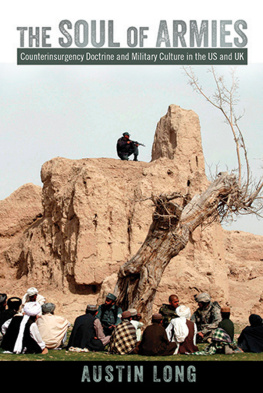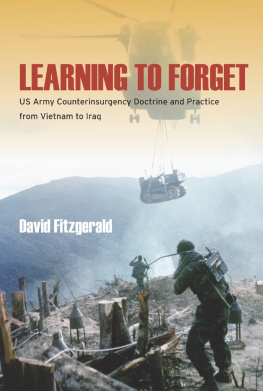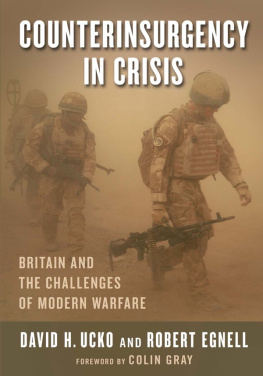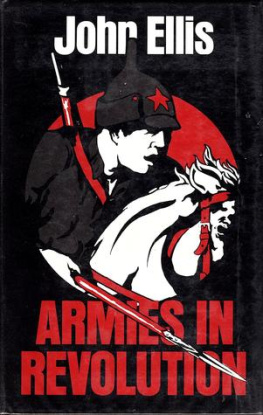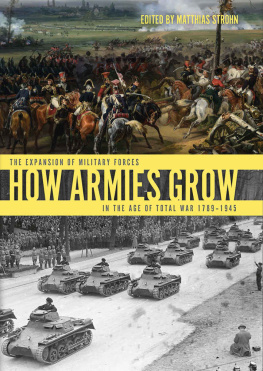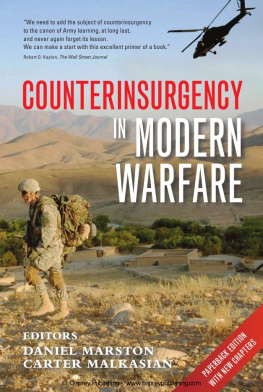Preface
The seed of this book was planted in 1992, when as a young undergraduate in physics I happened to pick up a book called The Army and Vietnam. The book convinced me that organizations and the ideas of organizations matter more than technology in the conduct of certain kinds of war, most notably counterinsurgency. The initial idea for the book was that some organizations are more successful than others at counterinsurgency for reasons deriving from the organizations culturethe latter defined as a set of enduring organizational ideas about war.
More than two decades later, and after spending time in the midst of counterinsurgency in both Iraq and Afghanistan, I find that the resulting book is rather different than I anticipated when I began. I conclude that organizational culture does matter a great deal in how military organizations conduct counterinsurgency operations. Indeed, I am more convinced of this than ever based on both firsthand observation and careful comparison of detailed operational records.
I am now equally convinced that these differences in operations are only a partial explanation for success or failure in counterinsurgency. This probably comes as no surprise to any serious student of counterinsurgency, or even warfare generally. The operational and tactical excellence of Hannibal did not yield strategic success against Rome, nor did the collective brilliance of the Wehrmacht against the Allies.
Yet much of the counterinsurgency literature, and certainly the literature in English, implicitly assumes that if only the right mixture of operational measures is adopted, then success is all but assured. Essentially, counterinsurgency is not much different from baking a cake. However, unlike bakers, counterinsurgents confront not only an adversary that can adapt but also a variety of other actors, ranging from local populations to allied governments. Each of these gets a vote in determining the success of counterinsurgency.
The conclusion of this book is therefore, all things being equal, that some military organizations are more likely to conduct counterinsurgency operations that will lead to success than others. Of course, all things are seldom equal. So rather than being a book about why some military organizations succeed or fail at counterinsurgency, this is a book about why military organizations are the way they are, and how that affects the way in which they conduct counterinsurgency. This has implications for success or failure in counterinsurgency but is not, alas for parsimonious social science, dispositive.
Organizational culture is nonetheless important to understand, as it has very real implications both for scholars and for policymakers. For scholars, understanding organizational culture helps explain variations in operations that are otherwise unexplainable. In chapter 7, for example, the variation in U.S. Marine Corps and U.S. Army operations in the same province of South Vietnam is very difficult to explain without reference to organizational culture.
For policymakers it is critical to know that, at least for counterinsurgency, different organizations will conduct operations in ways that are more or less likely to produce success, will produce more or fewer civilian casualties, and the like. Even if particular operational approaches cannot guarantee success, policymakers should understand the military tools they have to work with. Likewise, if policymakers provide resources to organizations, they should understand how those organizations are likely to use those resources.
Whatever insight this book provides is a result of a great deal of support, and as a result I owe a great deal to a great many people and organizations. The Massachusetts Institute of Technologys Security Studies Program, led first by Harvey Sapolsky and then by Barry Posen, was the intellectual home for initial work on this project. The RAND Corporation, particularly the International Security and Defense Policy Center led by James Dobbins and the Intelligence Policy Center led first by Kevin OConnell and then by John Parachini, gave me another hospitable intellectual home and the opportunity to work on a variety of projects that broadened my understanding of military and intelligence operations generally and counterinsurgency specifically, as well as the chance to see counterinsurgency up close and personal in Iraq and Afghanistan.
Columbia Universitys Saltzman Institute for War and Peace Studies and the School of International and Public Affairs have provided substantial support for further development of this work, most notably in having patience as I would wander off to Iraq, Afghanistan, and other such fun locales. Columbias Harriman Institute for Russian, Eurasian, and East European Studies also provided financial support for the research and production of this book. The manuscript was finalized while I was an International Security and U.S. Foreign Policy Fellow at Dartmouth Colleges Dickey Center for International Understanding. I am deeply indebted to MIT, RAND, Columbia, and Dartmouth.
Several other organizations also provided me with opportunities and funding that either directly or indirectly influenced my thinking about the topics covered in this book. Research conducted for the Office of Net Assessment in the Office of the Secretary of Defense and for the U.S. Navys Program Management Activity-280 (Tomahawk All Up Round) shaped my thinking about military organizations and the environments, domestic and international, in which they must operate. Finally, a World Politics and Statecraft Fellowship from the Smith Richardson Foundation provided funding for archival research as well as field work in Afghanistan and Pakistan.
All of the following have read and commented on drafts of this manuscript: Michael Beckley, Rosella Capella, Owen Cot Jr., Brendan Green, Llewelyn Hughes, Colin Jackson, Jennifer Lind, Jon Lindsay, Thomas McNaugher, Will Norris, Barry Posen, Daryl Press, Josh Rovner, Harvey Sapolsky, Paul Staniland, Caitlin Talmadge, Benjamin Valentino, and William Wohlforth. I am grateful to all of them for their time and attention, which improved many aspects of my argument.
I was fortunate in finding many friends in the U.S. military and intelligence community who provided excellent insight into the workings of military organizations as well as the conduct of modern counterinsurgency. I particularly thank Lieutenant Colonel Ray Gerber (USMC), Colonel Chris Conner (ret.) (USA), Colonel Brooks Brewington (ret.) (USMC), Brigadier General Dale Alford (USMC), Colonel Pat Stackpole (ret.) (USA), Colonel George Bristol (USMC), Colonel John Agoglia (ret.) (USA), Colonel Ray Coia (ret.) (USMC), Brigadier General Billy Don Farris (ret.) (USA), Colonel Bruce Moose Danskine (USAF), First Lieutenant Matt McKnight (USMC), Colonel Phil Goldie Haun (USAF), and Captain Van Gurley (ret.) (USN), along with others who do not wish to be individually identified. I also thank two officers of the Canadian Army, Lieutenant Colonel Harjit Sajjan and Major Harpal Manny Mandaher, along with Carter Malkasian of the Center for Naval Analyses, for sharing their insights on counterinsurgency. I am especially indebted to retired Central Intelligence Agency officer turned CIA historian Thomas Ahern for sharing his unique perspective and wisdom on counterinsurgency in Southeast Asia and beyond.
The records at the Texas Tech University Vietnam Archive, the National Archives of the United Kingdom, the U.S. Armys Combined Arms Research Library, and the U.S. Marine Corps Alfred M. Gray Research Center were all important in reconstructing history. I thank the staff of each of these institutes for their diligent work in making these records available online, in hard copy, or both. I also thank the staffs of MITs Dewey and Hayden Libraries, Harvard Universitys Widener Library, and Columbia Universitys Lehman and Butler Libraries for their assistance over the years.

